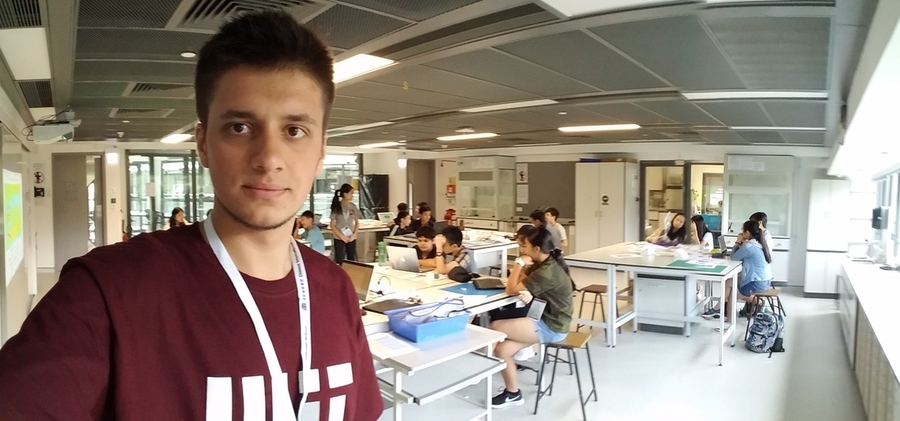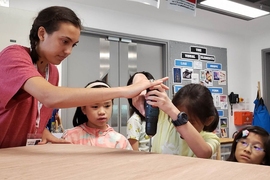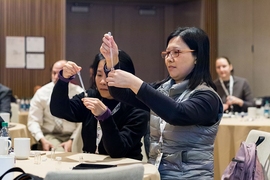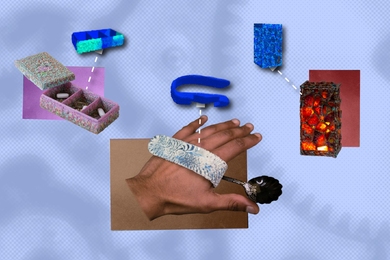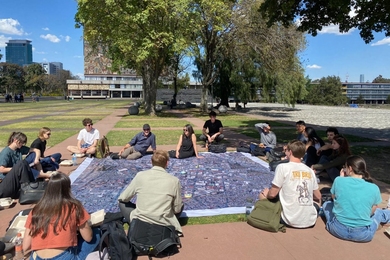MIT senior Bahrudin Trbalic wants pre-kindergarten through 12th grade (pK-12) students around the world to love learning about physics and engineering as much as he does.
As a young student in Bosnia, he participated in STEAM (science, technology, engineering, arts, and math) camps led by older students, eventually competing at the International Physics Olympiad and organizing his own physics camps for middle schoolers. He credits the learning and the friendships gained from these experiences — often cultivated in hands-on, makerspace settings — with helping him on his path to MIT.
“I’m studying physics and electrical engineering at MIT, because I believe that these subjects will help me to be the best educator I can be,” Trbalic says. “I’m sad when I see young students in classrooms just looking at whiteboards, struggling to grasp the concepts. Students love it when we give them equipment and a task, and room to explore around.”
Over the summer, Trbalic brought this passion for project-based education to a series of STEAM camps led by the MIT Abdul Latif Jameel World Education Lab (J-WEL). Researchers and educators from J-WEL worked closely with the MIT pK-12 Action Group to design modules for young learners, and with the MIT Playful Journey Lab to incorporate professional development for local teachers into the camps.
Trbalic was one of 13 MIT students who traveled to the camps this summer to help bring the MIT approach to pre-K-12 education to local communities.
Learning through projects
Claudia Urrea PhD '07, senior associate director of J-WEL pK-12 and founder of the MIT STEAM camps, says that the genuine care for the local participants that MIT students like Trbalic bring to the program communicates a message that MIT “cares about the hearts of students as much as the minds and hands.”
The camps create for the young participants an opportunity to have a type of engaged, hands-on learning experience that closely resembles MIT’s approach to learning on campus. Joe Diaz ’11, program coordinator of the pK-12 Action Group, says that the goal is to provide an experience that might be new and different from the students’ typical classes in school.
“Just by definition, activities are more open-ended and have project-based learning elements, so they’re usually hands-on and not just listening to a teacher while trying to memorize information,” says Diaz.
Beyond the young learner experience, these programs immerse teachers in new ways of teaching and thinking about education.
“The camp is an opportunity for the kids,” says Urrea, “but also an opportunity for the teachers to learn about project-based learning and how to facilitate this kind of active learning, this MIT way of learning.”
The program in Hong Kong, now completing its third year, brought a small group of MIT students to serve approximately 185 local students at the Chinese International School through collaboration with the Catalyst Education Lab.
The theme for this year’s camp was “Air,” in an effort to inspire students to think about air quality, science, and engineering. The modules covered topics such as aerodynamics, rocket building, satellite construction, musical wind instruments, and data sonification.
Building on what has been learned from the camps in Hong Kong, MIT has begun pilot programs in Athens, Greece, and Suzhou, China. While the camps in each of the locations are designed for the different local contexts, they are united with common goal.
“We want to engage young learners in a powerful experience that enables them to make connections with their interests and passion, that encourages them to design and test their own ideas, and that empowers them to imagine new futures,” Urrea says.
Igniting creativity
Trbalic participated in STEAM camps in both Hong Kong and Suzhou. He describes a typical day as starting out early with a welcome and icebreaker games in an effort to get to know young participants and to establish a friendly atmosphere. Classes were structured around questions and exploration. For example, for a class on animal aerodynamics, the teachers would ask, “How can birds fly?” while introducing the idea using computer simulations of flight.
Next, the students rolled up their sleeves to begin their projects. They drew animals with wings — sometimes birds, but also elephants and other creative takes on nature — which the MIT students helped them to laser cut into prototypes. They then built a wind tunnel in which they could watch their creations fly. Through the project, students studied the concept of airflow, turbulence, and the ways that shape influences air circulation.
“We recognize that physics can be difficult to grasp. We try to use a more hands-on, practical approach,” says Trbalic.
Beyond the modules designed by members of the MIT pK-12 community, in the second week of the camp students tackled a specific project they had in mind — addressing a problem they observed by testing potential solutions. They went through the engineering process — discussing, drawing designs, and building prototypes. One team, for example, built a floating water turbine — a turbine that rests on a river and uses the motion of the water to make a turbine spin and ultimately produce electricity for an LED light bulb.
“Their creativity was amazing,” says Trbalic of the students at the camp. “We’d give them cardboard, and they built such amazing things. I’m sure that if they had a whole month, they’d have come up with a robot.”
Giving back
Trbalic is looking ahead to graduate school, and sees his future in the classroom — as a professor or in another teaching position with an emphasis on physics. He is currently working on a startup through MIT Sandbox. He and three colleagues from Bosnia have identified a lack of practical education in their home country. They are creating kits with materials students can use to explore the physical world, measuring a broad range of signals like temperature, pressure, gas concentration, volume, sound, and light intensity.
“We hope to motivate students to perform experiments at home on their own,” says Trbalic. “They don’t need to be afraid of breaking equipment and they know that they won’t be graded. We want them to explore physics and to learn from it.”

